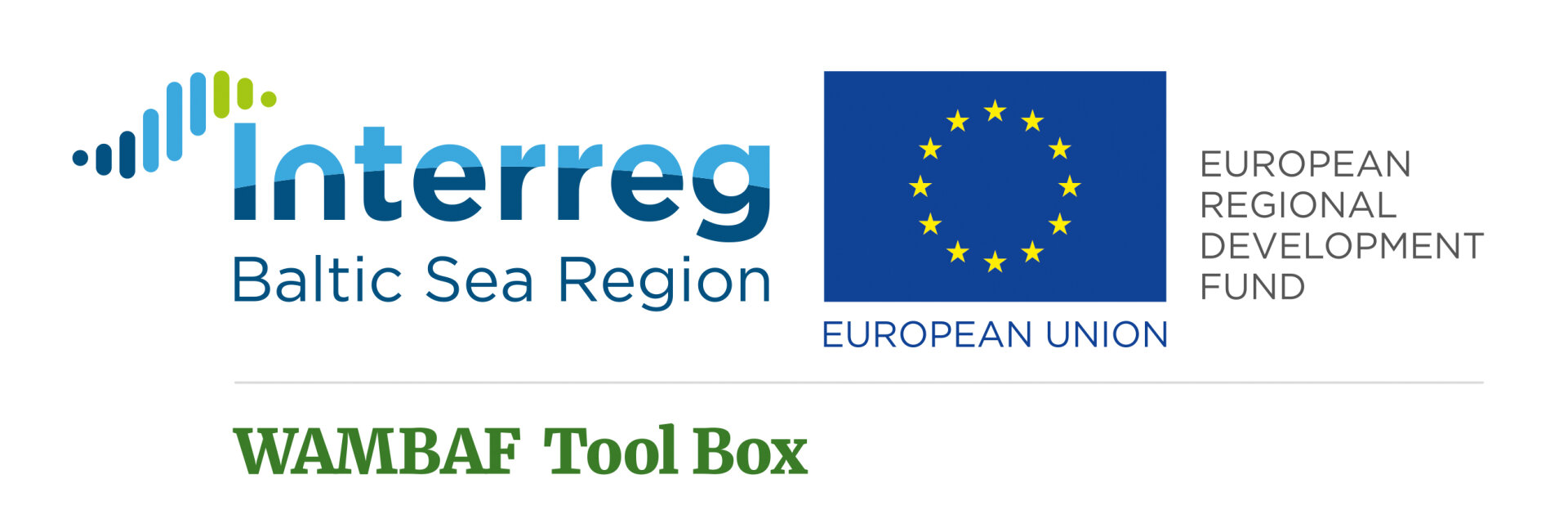


Project: WAMBAF Tool Box, Index No.: X1.005, Project No.: #X007
Coordinator: Dr. Olgirda Belova, Institute of Forestry LAMMC
Project description
Project title: WAMBAF Tool Box
Research priority: Natural resources
Project duration:
Contracting start: 12/04/2019; contracting end: 31/07/2019
Implementation start: 01/08/2019; implementation end: 31/01/2021
Duration of implementation phase (months): 18
Closure start 01/02/202; Closure end 30/04/2021
Project partner No.: PP5
Legal person: Lithuanian Centre for Agriculture and Forestry (LAMMC)
Lead Partner (PP1): The Swedish Forest Agency; www.skogsstyrelsen.se/en/wambaf
|
Contacts Dr. Olgirda Belova (coordinator) Dr. Marius Aleinikovas, senior researcher Dr. Dovilė Čiuldienė, young researcher Egidijus Vigricas, engineer Odeta Skaisgirienė, financial manager Address: Liepų g. 1, Girionys, LT- 53101, Kaunas district, Lithuania Work Packages: WP1 (Project management) Steering committee: Each partner is represented in the Steering Committee of WAMBAF Tool Box. Management Team: The Management team is comprised of the Lead partner. Members of the management team communicate daily or weekly, mainly via Skype, phone and e-mail. WP2: 2.1 Machine Learning Wet Area Maps: can tell us where to drive and where not to drive in the forest, to avoid negative impact on water quality. New machine learning digital wet area maps for the management of riparian forests are more accurate than the earlier used depth to water maps, and cover, not only the demonstration areas but a substantial part of the forests in the BSR and are produced using GIS based topographic, forest and soil information. 2.2 Upscaling and mitigation of beaver impact: can serve as a decision support, concerning beaver ponds on landscape level connected to water quality and climate change 2.3 Upscale and digitalize Blue Targeting: the tool will be adapted to NW Russia, and made into a digital smartphone application for easier smooth and easy use in the field conditions and transfer of data to the office use. 2.4 Films: the films about forestry operations with good water consideration, will be translated to local languages to make them easier to understand 2.5 Drainage manual: a practical help for the machine operators to perform drainage operations. This manual embraces detailed instructions, including list of materials and technical descriptions on how to construct the different water protection systems, which were described in the drainage guidelines produced within WAMBAF project. WP3: 3.1 Training courses 3.2 Action plan meetings 3.3 New demo site in southern Finland For the successful implementation of WAMBAF Tool Box its partnership is built to consist of public authorities, forest enterprises, NGOs and research organisations from six BS countries (Sweden, Finland, Latvia, Lithuania, Russia and Poland). To strengthen the possibilities for further implementation, NGO WWF Russia was approved as a partner in WAMBAF Tool Box. WWF Russia has a high knowledge in the natural given circumstances of NW Russia and cooperates closely with local forest enterprises. Partners
Note: * Lead partner (LP) A number of associated organisations including NGOs, a forestry schools, forest companies and other relevant stakeholders, are involved to increase the levels of governance from local to regional and from governmental to non-governmental including the private sector and the geographical coverage in the BSR. Several small-, medium- and large-sized private and state-owned forest enterprises participate most as associate organisations. They manage state and private forests in the BS countries and their active role is important for implementation of the planning tools. Enterprises from the following BS countries are involved in WAMBAF Tool Box: Sweden, Finland, Poland, Russia and Lithuania. Some of the enterprises operate in several BS countries. Associated partners (Lithuania): AO 5 Kretinga Regional Division of State Forest Enterprise AO 4 Forest and Land Owners' Association of Lithuania (FOAL) The target group involves forest enterprises, including forest machine operators, forest managers, forest planners and contractors; land owners; authorities; and hunters. The public authorities have been selected at national and local levels from the countries with competence on legislation, regulations and guidelines, and are also important actors in implementing the outputs to policies, regulations and guidelines. The expected change is to reach the key persons that work with forestry in the BSR. This is essential since it is the people's knowledge and changed behaviour that will make change - leading to reduced inflow of nutrients and hazardous substances in the regional and coastal water, a lower level of eutrophication and toxic in the Baltic Sea. The project will actively contribute to this via the training courses, a new demo area and easy-to-use tools. |
WAMBAF Tool Box
WAMBAF Tool Box is a joint project between public authorities, non-governmental organizations, forest enterprises and research organizations from Sweden, Finland, Latvia, Lithuania, Russia and Poland.
WAMBAF Tool Box is based on results and experience from the regular project WAMBAF.
The project runs from 2019-04-12 to 2021-01-31.
The aim of the project is to upscale and adapt the tools that were developed in the previous WAMBAF project, and to implement the tools to a wider target group. The tool boxes comprised films, planning tools, guidelines and a beaver handbook. WAMBAF Tool Box will implement solutions for forestry to reduce the inflow of nutrients and hazardous substances to the regional and coastal waters of the Baltic Sea Region.
The project deals with challenges connected to forestry operations carried out along streams, as well as the impact of beaver dams. The project implements solutions to reduce the inflow of nutrients and methyl mercury to the regional and coastal waters of the Baltic Sea Region. If forestry is not performed in the best possible way, nutrients and methyl mercury can be exported from forests to streams, lakes and the Baltic Sea. This can lead to eutrophication, decreased biodiversity and to poisonous levels of mercury in fish.
Details about the project are found in system BAMOS https://ba.bamos.eu/ and in webpage of WAMBAF Tool Box https://www.skogsstyrelsen.se/en/wambaf/
More about project results:
https://www.skogsstyrelsen.se/en/wambaf/beaver-dams/